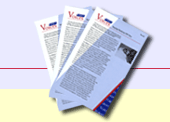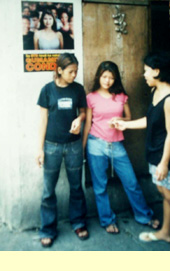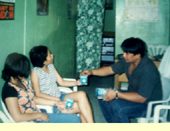
Integrating Family Planning with HIV Prevention for High-Risk Youth
“When clients inquired about various family planning methods in the past, we were usually unable to give them relevant information since we were more focused on HIV/AIDS prevention. Now, we can easily explain and promote dual protection.”
With assistance from the PRIME II Project, Julie Generalao integrated family planning counseling into her activities to prevent HIV/AIDS and other sexually transmitted infections (STIs) in Cebu City, Philippines. Generalao and her fellow Community Health Outreach Workers (CHOWs) are instrumental in reaching high-risk adolescents, including young female sex workers, their clients and partners.
Because Filipino adolescents are reluctant to access government-run health clinics, PRIME concentrated on non-traditional, frontline providers—CHOWs and peer educators linked with the USAID-funded AIDS Surveillance and Education Project (ASEP)—to improve access to family planning counseling and services. In collaboration with the Department of Health and local nongovernmental organizations, PRIME partner PATH implements the educational component of ASEP, a multi-year project that targets population groups routinely practicing risky sexual behavior.
Street-savvy young CHOWs and peer educators are the main source of health information for many adolescent sex workers and their clients in the tough environments of red-light districts, port areas and city slums. Building on these hard-won relationships, the PRIME-assisted intervention stressed condom use with all partners to prevent STIs and HIV while also encouraging dual protection—condom use combined with another form of contraception—for more reliable prevention of unwanted pregnancies. Nongovernmental organizations implemented the intervention in four ASEP locations: Angeles, Cebu City, Iloilo and Zamboanga City.
In keeping with PRIME’s emphasis on integrating consumer perspectives to improve health service delivery, adolescent sex workers and their partners were asked about their information needs and service delivery preferences. This input contributed to the design of the intervention and supporting materials, including pocket-size fold-out pamphlets for adolescents to quickly reference facts about condoms and dual protection and where to locate youth-friendly pharmacists.
Together with ASEP partner organizations, PRIME improved CHOWs performance by providing refresher training on dual protection and developing job aids that standardize performance expectations for counseling sessions with adolescent sex workers and other high-risk youth. Topics include STI/HIV prevention and proper condom use, negotiating condom use with partners, prevention of unwanted pregnancy, and risk reduction counseling to help adolescents recognize and modify their behavior. PRIME also worked with ASEP partners to increase adolescents’ access to resources within the formal health care system.
“In addition to sharing family planning information, we established a referral mechanism for counseling on pregnancy prevention after linking with the government’s family planning program,” said Malou Lim, a program manager for Human Development and Empowerment Services, which implemented the intervention in Zamboanga City.
To gauge the effect of the intervention on adolescent behavior, in May 2003 PATH/Philippines and ASEP partner organizations conducted a behavior monitoring survey. Findings compared young female sex workers who were exposed to the intervention with a group that had no exposure. Exposed adolescents were significantly more likely to report condom use during last sex (76% versus 52%) and overall modern contraceptive use (93% versus 84%), encouraging indications that dual protection messages are having an impact. Adolescents exposed to the intervention were also significantly more likely to seek appropriate treatment for STI symptoms (76% versus 55%).
Offering promise for replication in other countries, this PRIME-assisted intervention shows that with simple, targeted messages for clients, non-traditional providers like Julie Generalao can successfully integrate family planning counseling into HIV programs, generating positive changes in health-seeking behavior and practice among the most elusive and high-risk groups of adolescents.
The PRIME II Project, funded by USAID and implemented by IntraHealth International and the PRIME partners, works around the world to strengthen the performance of primary providers as they strive to improve family planning and reproductive health services in their communities.
PRIME Voices #25, Philippines: Integrating Family Planning with HIV Prevention for High-Risk Youth, 12/18/03.
Photo credit: PATH/Philippines
|












